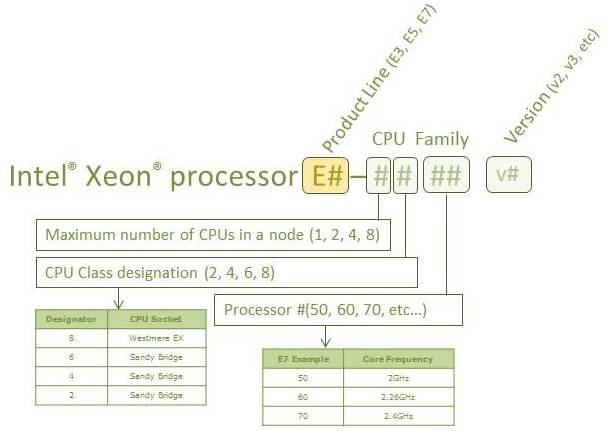It’s no surprise that Intel will be release a few new lines of CPUs this year, but in today’s post I thought I’d take a few minutes to highlight some of the details.
Intel to Change CPU Naming Schema
In an effort to simplify things, Intel will be changing the naming schema for their upcoming CPU releases. Starting with the product line names, in the near future the Intel Xeon 7000 will become “E7“, Xeon 5000 = “E5” and Xeon 3000 = “E3“. This means instead of seeing “Intel Xeon 7600”, you’ll now see something like “E7 – 4860” – but what does the “4860” stand for. That’s part two of the equation. If you take a look at the decoder ring below, you will see that in the case of the E7-4860, it would be a 4 socket, Westmere EX system with a core frequency of 2.26GHz.
E7 Overview (Westmere EX)
The successor to the existing 4 socket Intel Xeon 7500 CPU will be known as the E7 (codename Westmere EX). Building on the success of the Westmere EP architecture, this new generation of multi-socket offerings brings a few new features:
- up to 10 cores and 20 processing threads
- 30MB of last level cache (shared across all CPU cores)
- 32nm processor technology
- support for 32GB DIMMs
- 4 Intel QuickPath Interconnects
- 4 DDR3 memory interconnects
- drop-in compatibility with Xeon 7500 systems (this feature will be dependent upon the OEM manufacturer – not all will offer / support this feature.)
I don’t have the details on the specific models that Intel will be releasing when they announce in late Q2 of this year, but I expect to see variations from a 2 socket offering with a low frequency all the way up to an 8 socket offering with very high frequency. With power ratings as low as 95 watts, I hope to see the E7 in a blade server form factor, but I haven’t gotten any word on that – yet.
E5 Overview (Sandy Bridge)
Probably the most anticipated release is the Intel E5 CPU, aka Sandy Bridge. The two socket CPU space holds the largest market share in the x86 server space, and is the most commonly used platform for virtualization. Although the release date of this platform isn’t until the very end of 2011, it has gotten a lot of press lately, primarily because it has hit the desktop/notebook space first in the largest CPU launch since the Pentium. The new Intel i7 is indeed based on the Sandy Bridge CPU platform (although somewhat scaled back.) Here are the features that we can expect to see in the Intel E5 (Sandy Bridge) server platform:
- Up to 8 CPU cores (and 16 threads)
- 4 memory paths supporting memory speeds up to 1600Mhz
- 24 DIMM slots (768GB max)
- 2 Intel QuickPath links
An additional enhancement to the next generation Intel 2 socket CPU that is expected to rollout with the release of the E5 later this year is the addition of new Intel AVX instructions. Similar to the way the Pentium MMX worked back in the 90’s, the AVX instructions are designed to help the CPU do common tasks in fewer steps. Intel AVX improves performance due to wider vectors, new extensible syntax, and rich functionality. This results in better management of data and general purpose applications like image, audio/video processing, scientific simulations, financial analytics and 3D modeling and analysis. For details on the Intel AVX instructions, visit Intel’s site at www.intel.com/software/avx.
kohls printable coupons
2012 presidential election
lower back exercises
lady gaga snl
free coupons for groceries

Pingback: Kevin Houston
Pingback: Daniel Bowers
Pingback: unix player
Pingback: M. Sean McGee
Pingback: Kevin Houston